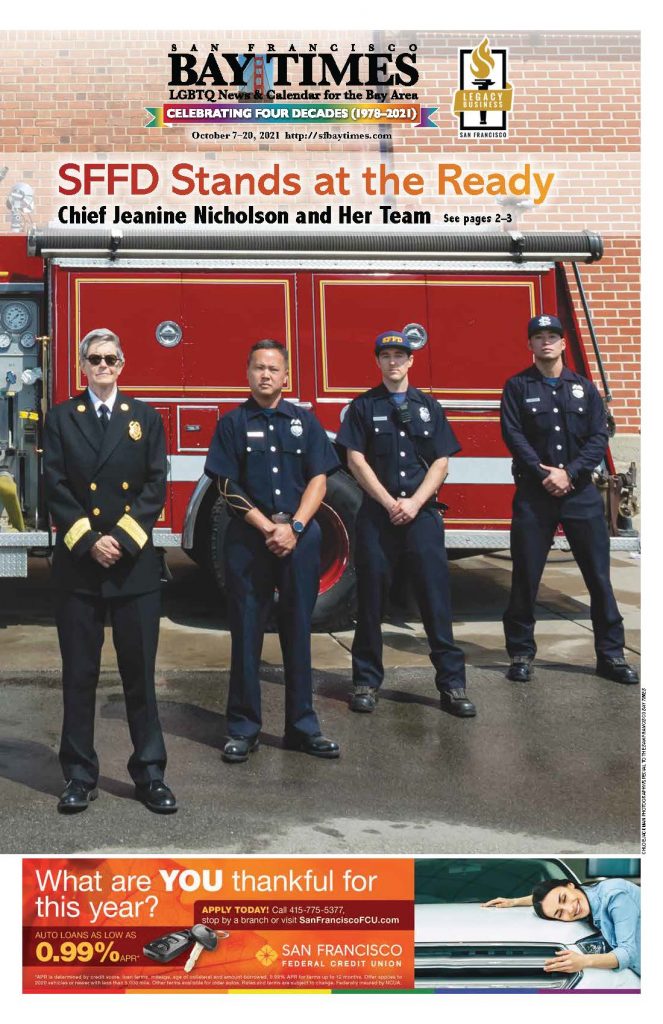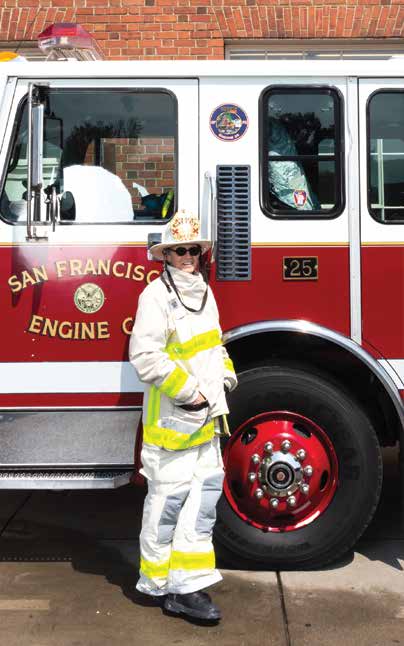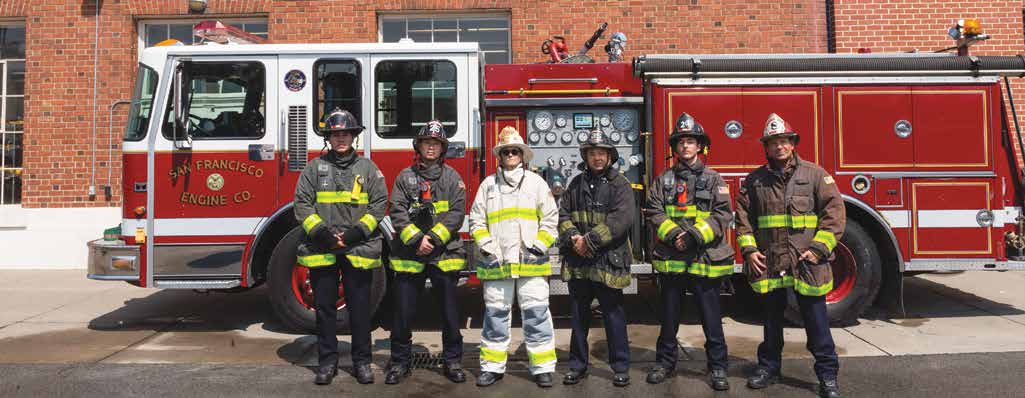
San Francisco Fire Department (SFFD) Chief Jeanine Nicholson, the first openly LGBTQ chief in the city’s history, has only held her position for a few years, and yet her accomplishments during this time—most of which has been during a challenging pandemic—are already many. They include helping to establish San Francisco’s Street Crisis Response Team and the Diversity, Equity & Inclusion Office, as well as groundbreaking work on firefighter safety, behavioral health, disaster preparedness, and community paramedicine.
On top of that, Chief Nicholson is successfully managing the day-to-day tasks of running one of the busiest fire departments in the nation. According to the Firehouse National Run Survey, San Francisco frequently ranks in the top 20 of the busiest fire departments nationwide when factoring in total annual fire and EMS (Emergency Medical Support) calls. SFFD reports that it serves an estimated 1.5 million people.
When Mayor London Breed appointed Chief Nicholson in March 2019 she said: “She has been on the front lines fighting fires, and she has saved lives as a paramedic, and she has done the complicated work as a deputy chief to manage multiple divisions. This woman is tough; this woman is resilient; this woman is a leader. I am confident she will be ready to lead the department on day one.”

Chief Nicholson has lived up to the high praise, and then some. On a national level, she has drawn positive attention to the SFFD for its service and ongoing efforts to promote diversity. We were honored when she recently agreed to an interview.
San Francisco Bay Times: We read that you grew up across the street from a fire station in New York. Please share your memories of those early years, in terms of the fire station and related happenings, as well as your father and grandfather both serving as volunteer firefighters.
Chief Jeanine Nicholson: Yes, I did indeed grow up across the street from a fire station in Pelham, New York. My father would bring me in there on Election Day when I was little. I never saw a female firefighter when I was in there and did not have a role model to [inspire me to] even think about the job then. But I was fascinated by all the equipment in the feel of the place. In addition, when there was a fire in town, the horns would sound a particular number, and we would go to our phonebook and look up the number and see what the address was of the fire. I was fascinated by all of this. My father and my grandfather were volunteer firefighters in Long Island, New York. My dad was thrilled when I became a firefighter. My grandfather was also a New York City police officer for many years before he was struck by a drunk driver and could no longer work as a police officer.
San Francisco Bay Times: What led to you moving to San Francisco, and what line of work were you in before joining the SFFD in 1994?
Chief Jeanine Nicholson: I moved to San Francisco from Boston in 1990. I had been here before to visit and I had many friends here. I was still searching for a career, so I was doing different odd jobs. I worked in construction for a while. I was a bartender for a while. But neither of those completely suited me. I always wanted to be of service in what felt to me in a meaningful way.
San Francisco Bay Times: Please share some memorable experiences from your time as a Firefighter EMT.
Chief Jeanine Nicholson: There are so many memorable experiences. Some of them happened in the firehouse with the camaraderie and the teamwork and the relationships that you build. We make and eat meals together. We do chores together and we live there together for 24 hours at a time. It is bonding like in no other city department. This is extremely important because, once we go out to a call, we always have to have one another’s backs whether it be at a fire or a vehicle accident or a medical call.
I have been to fires were people and animals have been rescued, and I’ve been to fires where there are deaths. We go to calls on the worst day of people’s lives, so I don’t feel right giving you details of those things. But suffice it to say that we work codes, which means we do CPR on people and try to resuscitate them. And we do not always succeed. So, we also have to interact with family members and friends who may be devastated by what is happening in front of them. We go to chaotic and traumatic scenes on a regular basis, whether it be a shooting, a stabbing, a car accident, or an overdose. There is a lot of suffering out there and I always did my best to bring my best self to those incidents.

San Francisco Bay Times: At age 49 and as a breast cancer survivor you broke the agility test record for the best time by a female firefighter: 8 minutes, 4 seconds. Do you know if that record still holds?
Chief Jeanine Nicholson: That record no longer holds. Another woman who was close to my age also returned from a breast cancer diagnosis and did it in well under eight minutes. She is a bad ass. But for myself, I have always taken pride in staying in shape and being fit. And, in fact, working out is part of my mental health regimen.
San Francisco Bay Times: Fast forward to the present, and in just a few years as Chief you have helped to launch major groundbreaking efforts such as the Street Crisis Response Team and the Diversity, Equity & Inclusion Office. Please provide a brief update on them along with other priority projects, such as Behavioral Health and Succession Planning.
Chief Jeanine Nicholson: Wow, there is a lot wrapped up in that question! First, I will talk a little bit about our community paramedic response. Community paramedics are different from the paramedics on our ambulances. They have additional trauma-informed training. They go out and meet people where they are to try to get them the services and connections that they need. This is to improve people’s quality of life and, in turn, this can decrease the number of 911 calls from a particular individual. They are able to build trust with many of their clients and patients. So, our community paramedics are medical professionals and part social worker. They do some case management and they are trained in de-escalation techniques. They are trained and educated so that they can properly relate to people from a trauma-informed perspective.
The Street Crisis Response Team is one of these community paramedics teams. They specialize in responding to behavioral health issues on the street. Sometimes those people do need an ambulance and sometimes they do not. Again, we try to meet people where they are and facilitate care and services for them. You can now see departments from all over the country that are standing up community paramedic and alternative responses to many of the issues on the street. The police have typically been the department to respond to all of these calls. We have been doing community paramedicine for many years in the SFFD, and now have expanded that team as part of the alternative to policing in San Francisco.
We also have a Street Opioid Response Team (SORT). We found that last year, when there were over 700 deaths due to drug overdoses, over 400 of those individuals had at one time been in one of our ambulances. What that indicates is that a predictor for someone to die of an overdose is a previously reversed overdose. SORT identifies, responds, and engages with survivors of non-fatal overdoses and individuals with opioid use disorder. They provide both harm reduction and abstinence-based connections, depending on the individual.
Overall, community paramedicine outreaches and responds to different types of incidents that an emergency room visit is not going to help. We have seen people cycle in and out of ambulances and ERs and not receive what they need to help them in the long run. This is some of the solution to that issue. Not every problem is a nail and not every fix is a hammer—or something like that! I could go on and on about community paramedicine. I have seen the work that is being done on the streets by our members and it is incredible and inspirational and life changing.
I stood up the first diversity, equity, and inclusion office (DEI) in the SFFD. While the SFFD is seen as a leader in diversity in the Fire Service across the United States, there is always more work to do. The DEI office is looking at these issues throughout the department, and not just in the hiring process. We are looking at it through promotional opportunities and succession planning and disciplinary proceedings and a multitude of other angles. I want to be able to give everyone the tools they need to succeed.
As an example, we are building up our own cadre of training instructors. The reason for this is that if a firefighter wants to go take a class, whether a state fire marshal class or some other class, they need to take time off and maybe travel to Sacramento or Los Angeles to take that class. Now a single parent may not be able to do that because of family commitments, whereas the single person may be able to do that. So, we want to be able to offer these classes in-house to everyone who wants them. We should be learning something new every single day we come to work, so we want to provide this additional support and opportunity for all of our members. In addition, San Francisco is an extremely unique city. With all the topography and architecture, and as we like to say “wooden boxes on hills,” it is important that we teach our members how to fight fires the San Francisco way and no one can do that any better than an experienced San Francisco firefighter.
In addition, the SFFD has spearheaded a new program in the city. It is called City EMT (similar to EMS Corps). It is a wraparound program for approximately three months for San Francisco at-risk youth from the ages of 18 to 25. They receive life coaching, trauma counseling, health and hygiene, budgeting, and an EMT class. And a stipend. Mayor London Breed showed up the first day to this program and advised these students that they were going to get a stipend each month so they could focus on this opportunity. She didn’t want anyone to be distracted by other challenges (such as food or housing insecurity). The young people are supported throughout. Many have gone on to earn their EMT licensure for California. And we now have five of these young people doing paid internships in the SFFD on our ambulances. This will give them experience to help them grow in their lives and in their careers, should they choose to be a member of the SFFD or not. Can you tell how excited I am about this program?!
Now for behavioral health, we have several employees dedicated to responding to our own members who are having challenging issues (such as divorce or a death in the family), or members who have been to an extremely stressful incident, or to many of them. Over our careers we see a lot of things that no other people see or frankly should ever see. This is part of the reason our bonds with each other are so strong, and that we have this understanding of one another. And many of us can use some extra support. So, we recently connected with a nonprofit called Thor’s Hope Foundation and they are providing us with two trained therapy dogs. We will have two different firefighters handling these dogs. The dogs will go to work with the firefighters and may be specially called to a fire station or a hospital to meet with an EMS crew or even to my office if I’m having a stressful day! This program will be implemented over the next several months.
San Francisco Bay Times: What has recent response been like for NERT (Neighborhood Emergency Response Team), and how do you view those efforts complimenting the work of the SFFD?
Chief Jeanine Nicholson: The NERT volunteers have been deployed throughout the pandemic. They have staffed vaccination centers and food pantries. These are wonderful people who are of service to their communities. In addition, NERT is designed to be helpful to the SFFD and the citizens of the City and County of San Francisco after an earthquake or other disaster. The 911 system may be overwhelmed with 911 calls after an earthquake, and there may be too many incidents for us to get to all of them. So, the SFFD and other public safety agencies in San Francisco will not be able to answer every call for help. NERT will fill in some of those places, whether it be triaging different streets for the amount and extent of damages and or injuries, or staffing their own community hubs or working side by side with us in the stations as ham radio operators. At the very least, NERT volunteers are trained in how to prepare themselves and their families in the event of a disaster, so that will be one less person calling 911.
San Francisco Bay Times: Please tell us about Camp Blaze and your experiences volunteering there.
Chief Jeanine Nicholson: Camp Blaze is a 100% volunteer organization staffed by women firefighters and their friends. It is a weeklong camp during the summer that is offered to approximately two dozen young women from the ages of 14 to 19. The camp is free to them. It is a leadership and empowerment camp based on firefighting skills. The two summers I was there I saw some of these young women come in very unsure of themselves and leave a week later really believing in themselves and having a bigger perspective on what could be possible for them. It was hard work and a whole lot of fun.
San Francisco Bay Times: October has seen some of the Bay Area’s most devastating fires, such as the Oakland Hills fire of 1991. What are your goals at SFFD to help prevent such fires, and is there anything that our readers can do, such as participating in NERT or something else, to help with these efforts?
Chief Jeanine Nicholson: Fortunately, in San Francisco we don’t have much in the way of wildfires. While we do have some brushfires and tree fires in our different parks—which we are completely prepared for—it is nothing compared to what is going on in other parts of California. We have seen what we call WUI or Wildland Urban Interface Fires. As we see our populations expand further and further into forests and nature, we see more fires. Add a severe drought (global warming) to that and these fires can be colossal. We have specially trained members within the department who volunteer to be deployed to these fires. We have deployed dozens of members to several different fires this year. They go for up to two weeks at a time. We will have sent numerous engines and strike teams to incidents. The fire season seems to get longer and longer every year. When I first came in, the season was from October for about three or four months. Now, NERT is a wonderful thing to have under your belt and we have deployed NERT volunteers to other disasters in the country as well.
San Francisco Bay Times: You are a tremendous role model for LGBTQ women, and particularly those who are first responders or hope to be. What advice do you have for such women, given that women and people of color are still in the minority at most major fire departments?
Chief Jeanine Nicholson: What I would tell people is it’s OK to dream big and expand your perspective on what you can do. Believe in yourself! And it is really important to have people in your corner who not only believe in you, but also can support and mentor you. You do not have to do it all alone. In addition, it can be very challenging for women and people of color in some departments (as the world in general can be). So again, have the support that you need in your corner. I believe representation is incredibly important and that diversity is our strength. That doesn’t mean there will not be bumps along the road. But you can do it! There is a lot of support!
San Francisco Bay Times: Please mention anything else that you would like Bay Times readers to know.
Chief Jeanine Nicholson: The SFFD stands ready to answer the call in San Francisco and throughout the state of California and elsewhere. We take great pride in what we do. It is an honor to serve the people of this city. I pinch myself every day because I won the lottery all those years ago when I was given an opportunity. And it was an absolute thrill for me to march at San Francisco Pride in 2019 as the Chief of the SFFD. I have never felt that much love and appreciation in my life. Wow. The queer community and allies were wonderful!
Published on October 7, 2021
Recent Comments